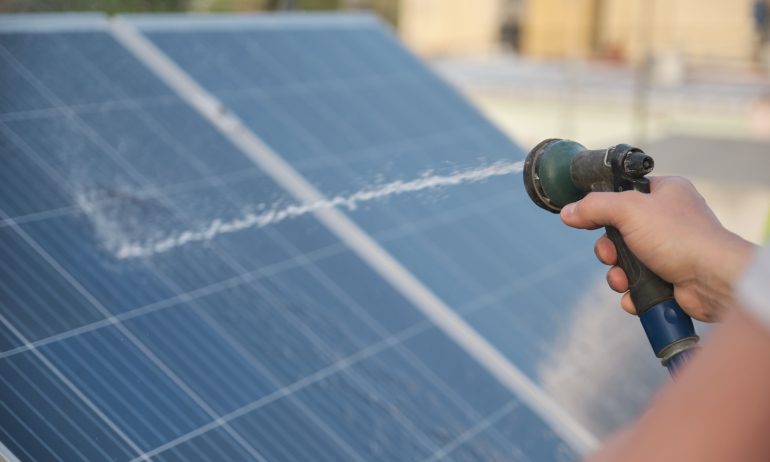Solar Panel Maintenance Tips: 6 Key Steps

Some or all of the mortgage lenders featured on our site are advertising partners of NerdWallet, but this does not influence our evaluations, lender star ratings or the order in which lenders are listed on the page. Our opinions are our own. Here is a list of our partners.
For solar panels to remain in top operating condition, you’ll need to keep them clean, trim foliage that blocks sunlight, inspect and monitor panels regularly, replace the inverter once during the lifetime of the panels and consider installing critter guards.
» MORE: Best solar companies of 2024
1. Minimize shade
Solar panels need lots of sunshine to produce optimum amounts of electricity. To minimize shade on your panels, inspect them regularly to see if trees or shrubs are restricting the sunlight — and if so, trim them back to allow as much sunshine as possible to shine on the panels.
Even if your solar panels were receiving full sunshine when installed, keep in mind that plant life grows, and what was once a sunny spot can become shaded.
Make sure that no other rooftop equipment (such as antennas, air conditioners, solar water heaters or satellite dishes) is casting shadows on the panels. If so, consider having that equipment moved.
Sometimes it’s not possible to move obstructions (such as a chimney or a neighbor’s large tree). In that case, consider using power optimizers or micro-inverters, which lessen the impact of partial shading on the entire solar panel system.
What you’ll pay to minimize shade depends on the work needed and who does the work. Professional tree-trimming services typically cost about $250 to $700 per tree — but could go up to $1,700 to $1,800, depending on the size of the tree and the complexity of the work.
» MORE: Do solar panels work at night?
2. Keep solar panels clean
Dirt, dust, leaves, pollen and other debris restrict the sunlight solar panels can receive.
But you won’t need to clean the panels every week (or even monthly), because most solar panels are installed at an angle, which lets rain do most of the work. Cleaning solar panels (or bringing in a professional to do it) one to three times annually should do just fine. Hiring a professional to clean your panels typically runs up to $25 per panel.
It’s important to use gentle, proper methods to clean solar panels, or you might void the warranty. Your solar provider may provide specific instructions, but these basic tips usually apply:
Don’t ever use abrasive cleaning chemicals on solar panels, as these could cause damage. Plain water from a garden hose is all you should need. If you feel you must use something to wipe the panels down, use only a soft squeegee or cloth specifically recommended by your solar panel manufacturer.
Don’t use abrasive tools (such as rakes or hard brushes) on solar panels, as this could damage them.
Always wait until solar panels are cool before cleaning them. Putting cold water on hot panels could cause them to crack.
Never walk or kneel on solar panels.
You may want to turn off the solar panel system during cleaning, particularly if you’re using a solar squeegee. This may avoid partial-shade issues.
» MORE: What are solar shingles?
3. Replace the inverter
Solar panels are designed to last 20 years or longer, but the life of a solar inverter may be somewhat shorter — on average, about 10 to 20 years. For this reason, you’ll want to monitor your inverter’s performance periodically, check for error codes and plan to replace the inverter once during the life of your solar panels. The cost of a new solar inverter typically runs from about $1,000 to $3,000 installed, so it’s wise to budget ahead for this expense.
4. Monitor the entire system regularly
To catch issues early (hopefully, while you’re still under warranty), monitor your solar panels regularly to make sure they’re operating efficiently and that they’re free of damage.
Schedule a professional annual inspection of the condition of your panels, electrical connections, utility meter hookup and inverter. A professional inspection may cost between $150 and $350.
Use a home monitoring system to stay aware of your system’s energy production and efficiency — with the understanding that slight drops of efficiency (about 0.5% annually) are normal and expected. Any drops higher than this amount should be addressed.
Examine panels after severe weather to determine if they’ve been damaged.
5. Install critter guards
The space under your solar panels may be attractive to small animals such as squirrels, birds, bats, raccoons and rodents. Unfortunately, if animals take up residence under your solar panels and begin to chew on the electrical wiring, this can cause electrical issues with the entire solar array. Also, nesting materials (such as small sticks and leaves) could cause a fire hazard if they build up under the wires. As well, droppings on the panels can inhibit sunlight, making your system less efficient.
A critter guard, which is just a simple flexible mesh barrier installed between the solar panels and your roof, keeps animals and their nesting materials out of the area and prevents leaves, sticks and other debris from falling into and collecting in that space without harming animals.
Critter guards cost about $500 to $2,000, depending on the size of your solar power system. If you’re comfortable with a DIY installation, you can purchase 50 feet of mesh online for less than $40, but make sure a DIY approach doesn't jeopardize the panels' warranty.
» MORE: Compare solar loans
6. Take advantage of your warranty
Catching issues early through proper maintenance of your solar panel system has an added benefit: some of these issues may be covered under the warranty. Depending on the warranty, these covered issues can include:
Damage to panels caused by manufacturer defect or improper installation.
Decrease of energy output beyond your warranty’s specifications.
Issues not generally covered by solar panel warranties include:
Damage caused by natural disasters, storms, fires, floods, lightning or acts of war.
Vandalized or stolen solar panels or equipment.
Routine cleaning and maintenance.
Labor (unless specifically included in your warranty).
Other system components such as solar batteries, wiring, racking and inverters. These components may be covered by their own separate warranties.
» MORE: What does a home warranty cover?
Keep in mind that certain types of improper care and maintenance of your panels can void your solar warranty, including:
DIY installations.
Using unapproved contractors to service your panels/system.
Tampering with electrical boxes or inverters.
Improper cleaning of solar panels, such as the use of abrasive tools or cleaning chemicals.
Not reporting problems right away.


